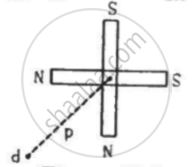Advertisements
Advertisements
Question
The magnetic moment vectors µs and µl associated with the intrinsic spin angular momentum S and orbital angular momentum l, respectively, of an electron are predicted by quantum theory (and verified experimentally to a high accuracy) to be given by:
µs = –(e/m) S,
µl = –(e/2m) l
Which of these relations is in accordance with the result expected classically? Outline the derivation of the classical result.
Solution
The magnetic moment associated with the orbital angular momentum is valid with classical mechanics.
The magnetic moment associated with the orbital angular momentum is given as
µl = `-("e"/(2"m")) "l"`
For current i and area of cross-section A, we have the relation:
Magnetic moment
µl = iA ……….(1)
Where,
e = Charge of the electron
r = Radius of the circular orbit
T = Time taken to complete one rotation around the circular orbit of radius r
Orbital angular momentum, l = mvr
L = `"m" xx (2π"r")/"T" xx "r"` ……….(2)
Where,
m = Mass of the electron
v = Velocity of the electron
r = Radius of the circular orbit
Dividing equation (1) by equation (2), we get:
`(µ_"l")/"T" = -("e"/(2"m"))`
µl = `-("e"/(2"m")) "l"`
APPEARS IN
RELATED QUESTIONS
Draw the diagrams showing the dipole moments in paramagnetic substance when external magnetic field is (a) absent (b) strong
Do two distinct poles actually exist at two nearby points in a magnetic dipole?
When a current in a circular loop is equivalently replaced by a magnetic dipole,
Let r be the distance of a point on the axis of a magnetic dipole from its centre. The magnetic field at such a point is proportional to
Two short magnets of equal dipole moments M are fastened perpendicularly at their centre in the Figure . The magnitude of the magnetic field at a distance d from the centre on the bisector of the right angle is

Pick the correct options.
(a) Magnetic field is produced by electric charges only
(b) Magnetic poles are only mathematical assumptions having no real existence
(b) A north pole is equivalent to a clockwise current and a south pole is equivalent to an anticlockwise current.
(d) A bar magnet is equivalent to a long, straight current.
A horizontal circular loop carries a current that looks clockwise when viewed from above. It is replaced by an equivalent magnetic dipole consisting of a south pole S and a north pole N.
(a) The line SN should be along a diameter of the loop.
(b) The line SN should be perpendicular to the plane of the loop
(c) The south pole should be slow the loop
(d) The north pole should be below the loop
A magnetic dipole of magnetic moment 0.72 A m2 is placed horizontally with the north pole pointing towards south. Find the position of the neutral point if the horizontal component of the earth's magnetic field is 18 μT.
A monoenergetic (18 keV) electron beam initially in the horizontal direction is subjected to a horizontal magnetic field of 0.04 G normal to the initial direction. Estimate the up or down deflection of the beam over a distance of 30 cm (me = 9.11 × 10–31 kg).
The orbital speed of an electron orbiting around a nucleus in a circular orbit of radius 50 pm is 2.2 × 106 ms−1. Then the magnetic dipole moment of an electron is:
